Simulation and Validation of an Incremental Bending Process for Cylindrical Fuselage Components
Abstract
:1. Introduction
- The stress state consists of a superposition of different stress types, which can lead to an inhomogeneous strain distribution and sheet thickness reduction [14].
- In combination with different flow path lengths, as shown by Panton et al. [15] for a roll forming process, this supports an unfavourable material distribution in the context of lightweight construction.
- The relative movement between the tool and the workpiece influences the surface of the components and makes the use of environmentally harmful lubricants necessary [16].
- In conventional stretch forming, the shape of the tool constrains the flexibility of the process [17].
- A necessary heat treatment during stretch forming of aluminium copper alloys such as EN AW-2024 increases the process time and the unit costs [14].
- Material waste is produced in stretch forming by removing the clamping areas [11].
2. Materials and Methods
2.1. Material Modelling
2.2. Numerical Setup
2.3. Experimental Setup
2.4. Evaluation Methods
3. Results
3.1. Validation Based on Sword Force
3.2. Validation Based on Cross–Sectional Inner Radius
4. Discussion
5. Conclusions and Outlook
Author Contributions
Funding
Data Availability Statement
Acknowledgments
Conflicts of Interest
References
- Lufthansa Group. New Normal; New Strength: Annual Report 2021. Available online: https://investor-relations.lufthansagroup.com/fileadmin/downloads/en/financial-reports/annual-reports/LH-AR-2021-e.pdf (accessed on 8 August 2023).
- Airbus Customer Services. Getting to Grips with Fuel Economy. Available online: https://ansperformance.eu/library/airbus-fuel-economy.pdf (accessed on 8 August 2023).
- Airbus, S.E. Orders and Deliveries in 2022. Available online: https://www.airbus.com/en/products-services/commercial-aircraft/market/orders-and-deliveries (accessed on 8 August 2023).
- Achternbosch, M.; Bräutigam, K.-R.; Kupsch, C.; Ressler, B.; Sardemann, G. Flow analysis–A comparison of manufacturing, use and fate of CFRP-fuselage components versus aluminium-components for commercial airliners. Fresenius Environ. Bull. 2002. [Google Scholar]
- European Union Aviation Safety Agency. Type-Certificate Data Sheet: No. EASA.A.064 for Airbus A318-A319-A320-A321; European Union Aviation Safety Agency: Cologne, Germany, 2022. [Google Scholar]
- Peng, J.; Li, W.; Wan, M.; Zhang, C.; Li, J.; Sun, G. Investigation on three-roller cylindrical bending of 2060-T8 Al-Li alloy plate for aircraft fuselage skin components. Int. J. Mater. Form. 2018, 11, 269–278. [Google Scholar] [CrossRef]
- Wang, Y.; Zhu, X.; Wang, Q.; Cui, X. Research on multi-roll roll forming process of thick plate. Int. J. Adv. Manuf. Technol. 2019, 102, 17–26. [Google Scholar] [CrossRef]
- Panton, S.M.; Zhu, S.D.; Duncan, J.L. Fundamental deformation types and sectional properties in roll forming. IJMS 1994, 36, 725–735. [Google Scholar] [CrossRef]
- Yoon, S.J.; Yang, D.Y. An Incremental Roll Forming Process for Manufacturing Doubly Curved Sheets from General Quadrilateral Sheet Blanks with Enhanced Process Features. CIRP Annals 2005, 54, 221–224. [Google Scholar] [CrossRef]
- Peng, J.; Li, W.; Han, J.; Wan, M.; Meng, B. Kinetic locus design for longitudinal stretch forming of aircraft skin components. Int. J. Adv. Manuf. Technol. 2016, 86, 3571–3582. [Google Scholar] [CrossRef]
- Lange, K. (Ed.) Handbook of Metal Forming; Society of Manufacturing Engineers: Dearborn, MI, USA, 1985. [Google Scholar]
- Delaunois, F.; Denil, E.; Marchal, Y.; Vitry, V. Accelerated Aging and Portevin-Le Chatelier Effect in AA 2024. MSF 2016, 879, 524–529. [Google Scholar] [CrossRef]
- Jambu, S.; Juhl, K.; Lenczowski, B. Method for Shaping Structures Comprised of Aluminum Alloys. WO 02/26414, 4 April 2002. [Google Scholar]
- Kurukuri, S.; Miroux, A.; Wisselink, H.; van den Boogaard, T. Simulation of stretch forming with intermediate heat treatments of aircraft skins. Int. J. Mater. Form. 2011, 4, 129–140. [Google Scholar] [CrossRef]
- Panton, S.M.; Duncan, J.L.; Zhu, S.D. Longitudinal and shear strain development in cold roll forming. J. Mater. Process. Technol. 1996, 60, 219–224. [Google Scholar] [CrossRef]
- Zhang, H.H.; Li, M.Z.; Fu, W.Z.; Feng, P.X. Numerical Simulation of Multi-Roll Stretch Forming Process with Different Lubrication and Rollers. AMM 2011, 110–116, 1512–1518. [Google Scholar] [CrossRef]
- Seo, Y.H.; Heo, S.C.; Park, J.W.; Ku, T.W.; Song, W.J.; Kim, J.; Kang, B.S. Development of Stretch Forming Apparatus using Flexible Die. Trans. Mater. Process. 2010, 19, 17–24. [Google Scholar] [CrossRef]
- Blazek, I.; Brestrich, M.; Frerichs, H.; Harms, M.; Lautenbach, S.; Eilert, W. Method and Arrangement for Changing the Shape of a Sheet-Like Workpiece. WO 2020/14793, 23 July 2020. [Google Scholar]
- Li, W.; Sun, Z.; He, K.; Zuo, Q.; Liu, Q.; Du, R. Study on Tool Path Design for a Novel Incremental Sheet Metal Bending Process. In Current Trends in Computer Science and Mechanical Automation; Wang, S.X., Ed.; De Gruyter Open Ltd.: Warsaw, Poland, 2017; Volume 2, pp. 437–448. [Google Scholar]
- Zhang, F.; He, K.; Wei, B.; Huang, B. Multi-point incremental bending of doubly curved high strength steel sheet under minimum strain energy loading path. Int. J. Adv. Manuf. Technol. 2023, 127, 1797–1809. [Google Scholar] [CrossRef]
- Gajjar, H.V.; Gandhi, A.H.; Raval, H.K. Finite Element Analysis Of Sheet Metal Airbending Using Hyperform Ls-Dyna. Int. J. Aerosp. Mech. Eng. 2007, 1, 395–400. [Google Scholar]
- Froitzheim, P.; Fuchs, N.; Flügge, W.; Woernle, C. Characterization of metal sheet forming by free bending with LS-Dyna. In Proceedings of the 15th LS-Dyna Forum, Bamberg, Germany, 15–17 October 2018. [Google Scholar]
- Fu, Z.; Chen, W.; Tian, X.; Hu, B. Modeling and simulation for multiple-step incremental air-bending forming of sheet metal. Int. J. Adv. Manuf. Technol. 2014, 72, 561–570. [Google Scholar] [CrossRef]
- Digital: The Next Horizon for Global Aerospace and Defense. Available online: https://www.mckinsey.com/industries/aerospace-and-defense/our-insights/digital-the-next-horizon-for-global-aerospace-and-defense (accessed on 19 July 2023).
- DIN EN ISO 6892-1; Metallic Materials–Tensile Testing–Part 1: Method of Test at Room Temperature. DIN German Institute for Standardization; Beuth Verlag GmbH: Berlin, Germany, 2020.
- Hockett, J.E.; Sherby, O.D. Large strain deformation of polycrystalline metals at low homologous temperatures. J. Mech. Phys. Solids 1975, 23, 87–98. [Google Scholar] [CrossRef]
- DIN EN ISO 10113; Metallic Materials–Sheet and Strip–Determination of Plastic Strain Ratio. DIN German Institute for Standardization; Beuth Verlag GmbH: Berlin, Germany, 2021.
- Peirs, J.; Verleysen, P.; Degrieck, J. Novel Technique for Static and Dynamic Shear Testing of Ti6Al4V Sheet. Exp. Mech. 2012, 52, 729–741. [Google Scholar] [CrossRef]
- Behrens, B.-A.; Rosenbusch, D.; Wester, H.; Dykiert, M. Comparison of different testing approaches to describe the fracture behaviour of AHSS sheets using experimental and numerical investigations. In Proceedings of the IDDRG 2021, Stuttgart, Germany, 21 June–2 July 2021. [Google Scholar]
- Becker, N.; Pöhlandt, K.; Lange, K. Improvement of the Plane-Strain Compression Test for Determining Flow Curves. CIRP Annals 1989, 38, 227–230. [Google Scholar] [CrossRef]
- Chermette, C.; Unruh, K.; Peshekhodov, I.; Chottin, J.; Balan, T. A new analytical method for determination of the flow curve for high-strength sheet steels using the plane strain compression test. Int. J. Mater. Form. 2020, 13, 269–292. [Google Scholar] [CrossRef]
- Merklein, M.; Biasutti, M. A Contribution to the Optimisation of a Simple Shear Test. KEM 2009, 410–411, 467–472. [Google Scholar] [CrossRef]
- Flores, P.; Tuninetti, V.; Gilles, G.; Gonry, P.; Duchêne, L.; Habraken, A.M. Accurate stress computation in plane strain tensile tests for sheet metal using experimental data. J. Mater. Process. Technol. 2010, 210, 1772–1779. [Google Scholar] [CrossRef]
- Isik, K.; Soyarslan, C.; Richter, H.; Tekkaya, A.E. Analysis of formability of advanced high strength steel sheets with phenomenologically based failure criteria with separate treatment of instability, shear and normal fracture. In Proceedings of the 8th European LS-Dyna Users Conference, Strasbourg, France, 23–24 May 2011. [Google Scholar]
- Barlat, F.; Brem, J.C.; Yoon, J.W.; Chung, K.; Dick, R.E.; Lege, D.J.; Pourboghrat, F.; Choi, S.-H.; Chu, E. Plane stress yield function for aluminum alloy sheets—Part 1: Theory. Int. J. Plast. 2003, 19, 1297–1319. [Google Scholar] [CrossRef]
- Behrens, B.-A.; Bouguecha, A.; Kammler, M.; Schrödter, J.; Hadifi, T.; Götze, T. Assessment of a Modified Tensile Specimen Geometry for the Characterization of 22MnB5 with a Quenching and Deformation Dilatometer. In Proceedings of the IDDRG 2012, Mumbai, India, 25–29 November 2012. [Google Scholar]
- Chaboche, J.L.; Rousselier, G. On the Plastic and Viscoplastic Constitutive Equations—Part I: Rules Developed with Internal Variable Concept. J. Press. Vessel Technol. 1983, 105, 153–158. [Google Scholar] [CrossRef]
- Suttner, S.; Rosenschon, M.; Merklein, M. Methodology for the parameter identification of the kinematic hardening law according to Chaboche and Rousellier. In Fortschritte in der Werkstoffprüfung für Forschung und Praxis; Verlag Stahleisen: Dusseldorf, Germany, 2013; pp. 205–212. [Google Scholar]
- Maker, B.N.; Zhu, X. Input Parameters for Springback Simulation Using LS-DYNA; Livermore Software Technology Corporation: Livermore, CA, USA, 2001. [Google Scholar]
- Müller, P.; Behrens, B.-A.; Hübner, S.; Jepkens, J.; Wester, H.; Lautenbach, S. Development of polygon forming processes for aerospace engineering. In Proceedings of the Sheet Metal 2023, Erlangen, Germany, 3–5 April 2023. [Google Scholar]
- Quirion, D.; Manna, M.; Hidalgo, S.; Pellegrini, G. Manufacturability and Stress Issues in 3D Silicon Detector Technology at IMB-CNM. Micromachines 2020, 11, 1126–1148. [Google Scholar] [CrossRef] [PubMed]
- Haufe, A.; Schweizerhof, K.; Dubois, P. Properties & Limits: Review of Shell Element Formulations. Available online: https://www.dynamore.de/de/download/papers/2013-ls-dyna-forum/documents/review-of-shell-element-formulations-in-ls-dyna-properties-limits-advantages-disadvantages (accessed on 23 December 2023).
- Livermore Software Technology (LST), An Ansys Company. LS-Dyna Keyword User’s Manual: Volume 2 Material Models. Available online: https://ftp.lstc.com/anonymous/outgoing/web/ls-dyna_manuals/R14/LS-DYNA_Manual_Volume_II_R14.pdf (accessed on 23 December 2023).
- Dunand, M.; Maertens, A.P.; Luo, M.; Mohr, D. Experiments and modeling of anisotropic aluminum extrusions under multi-axial loading–Part I: Plasticity. Int. J. Plast. 2012, 36, 34–49. [Google Scholar] [CrossRef]
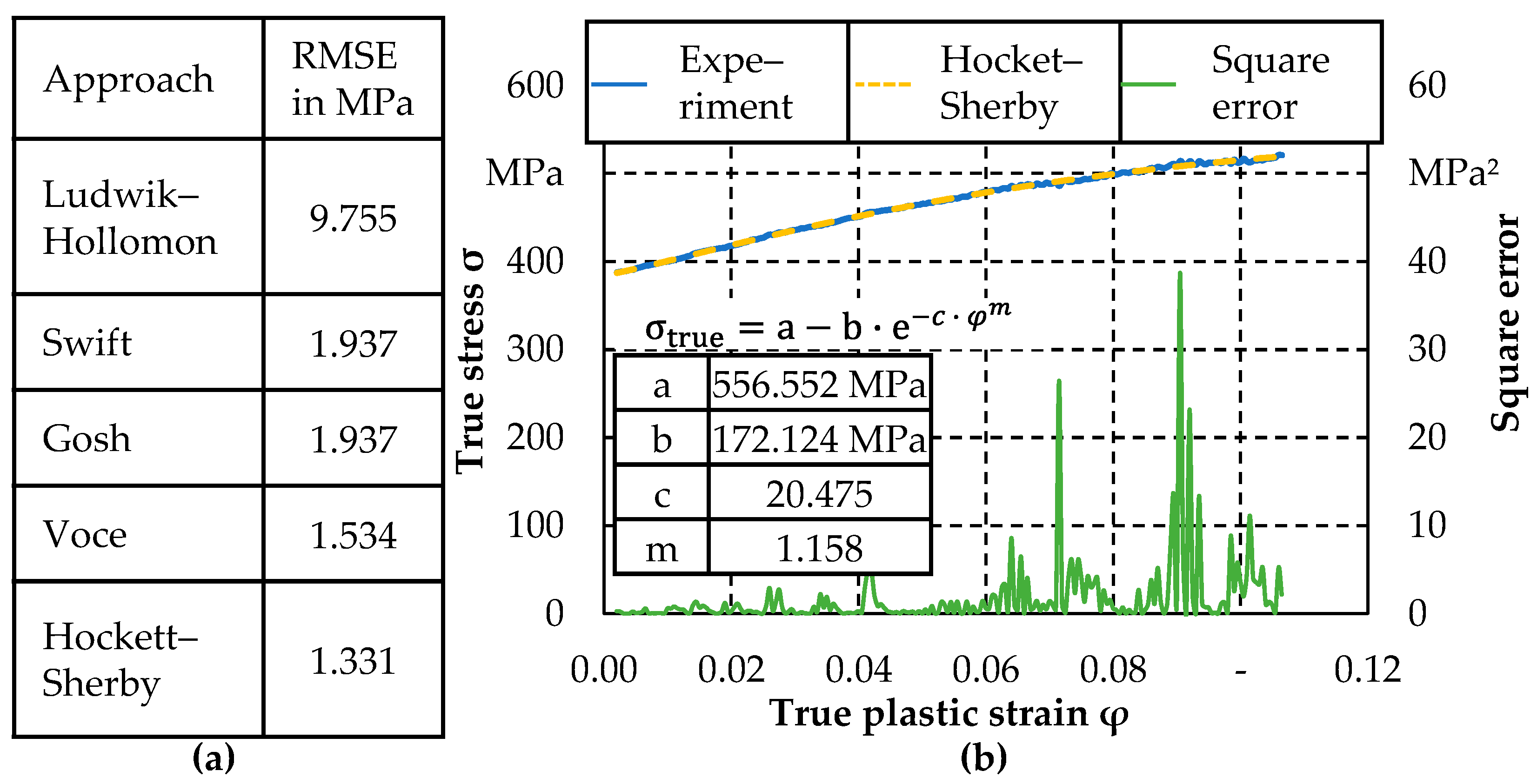
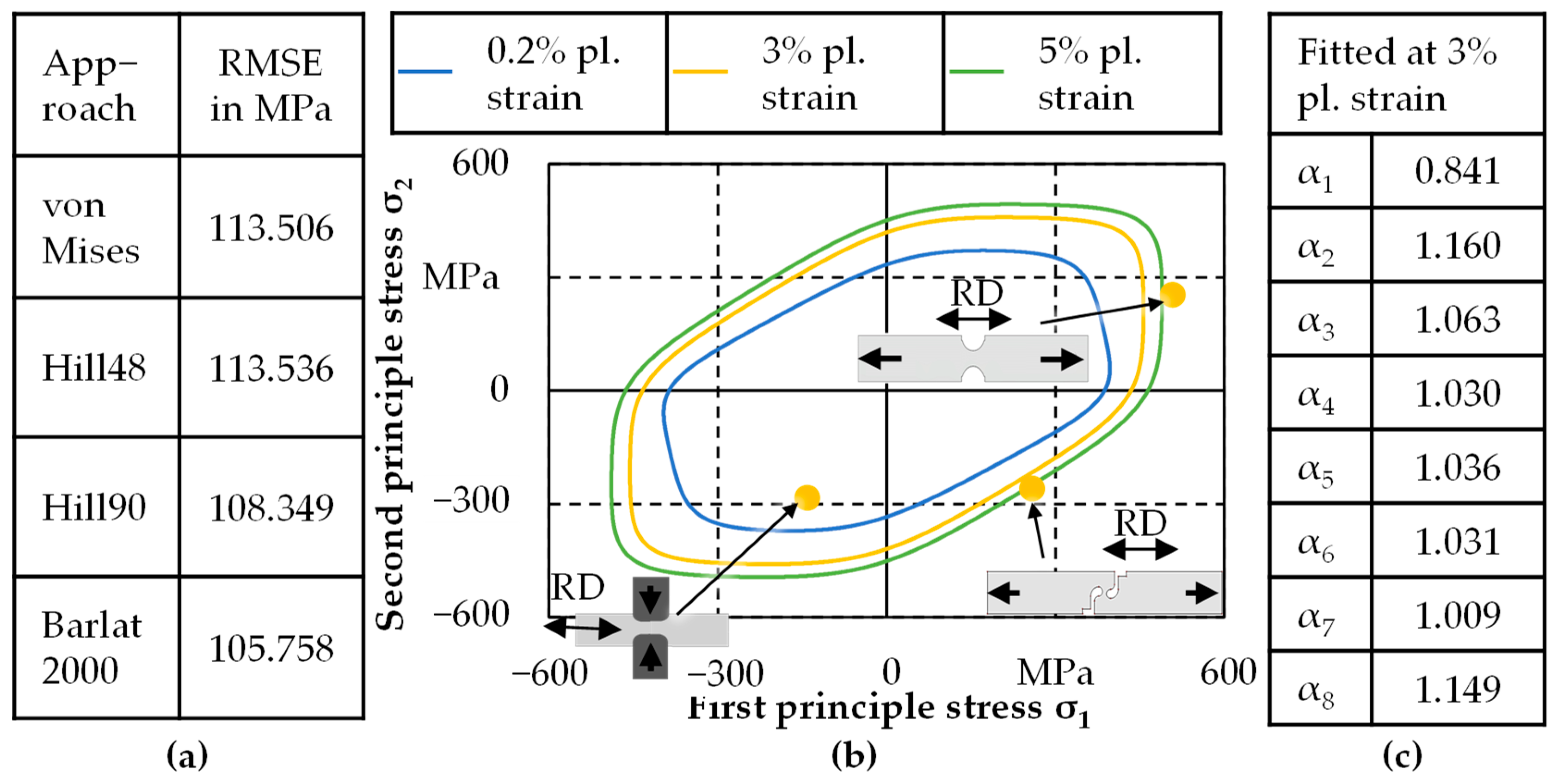
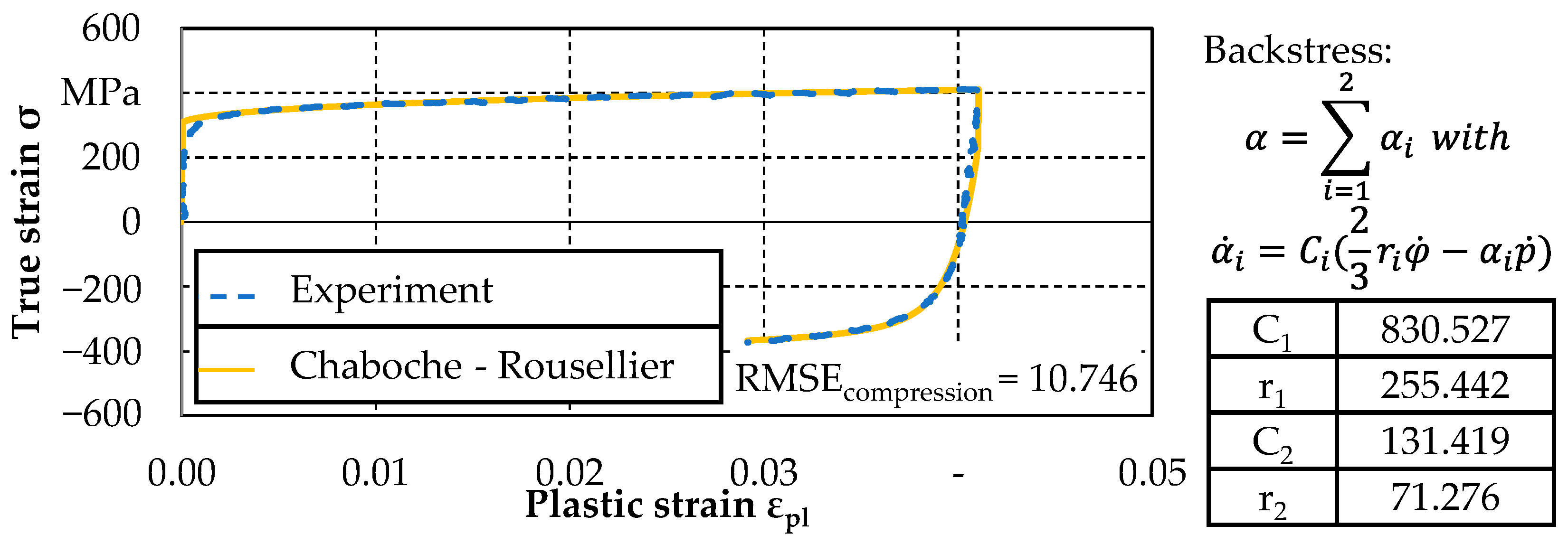
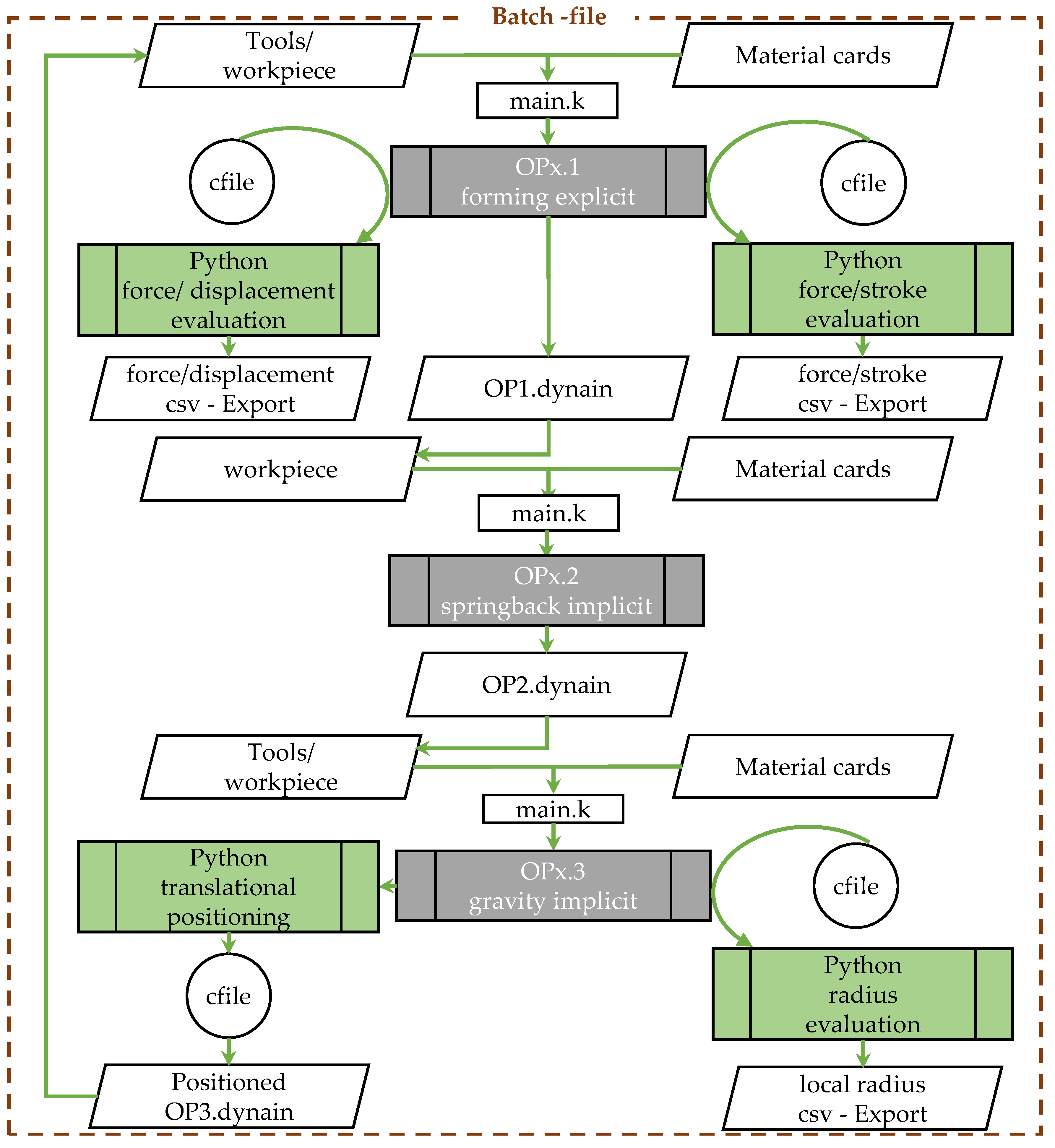
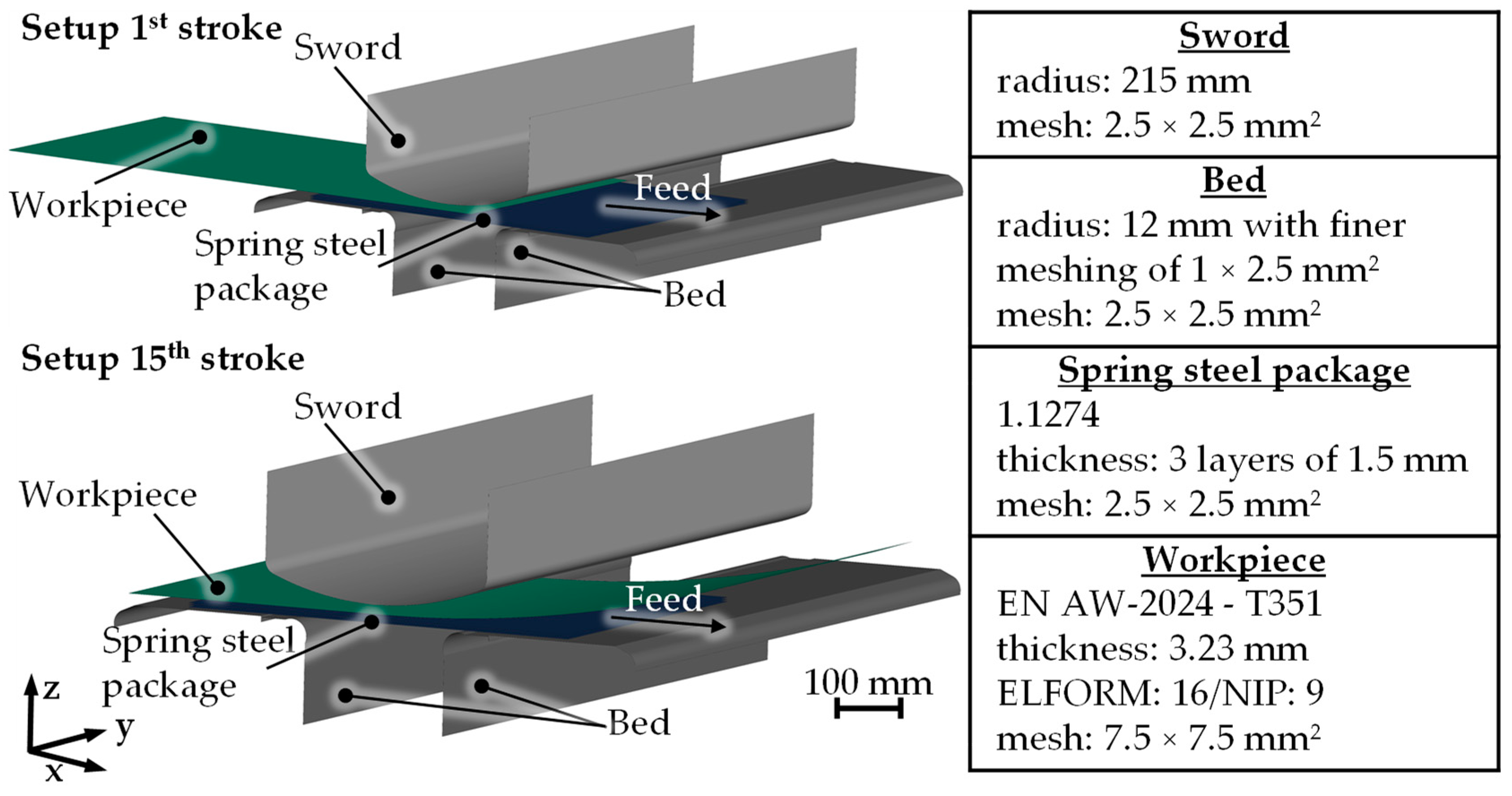
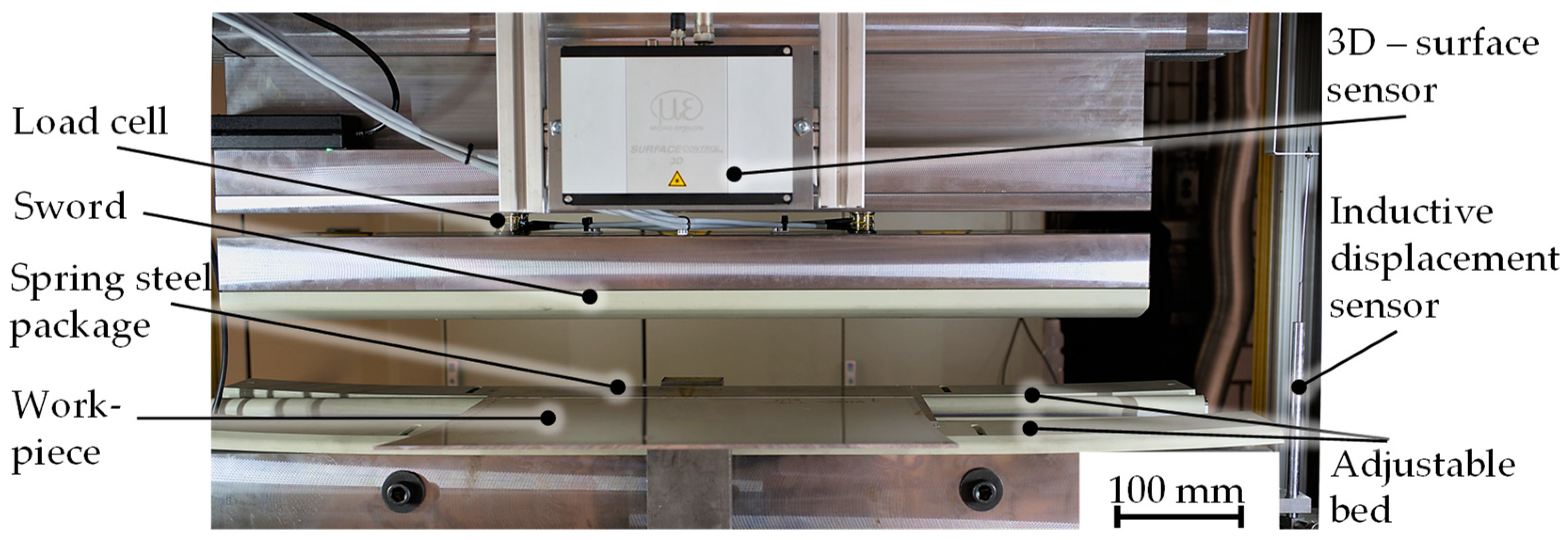

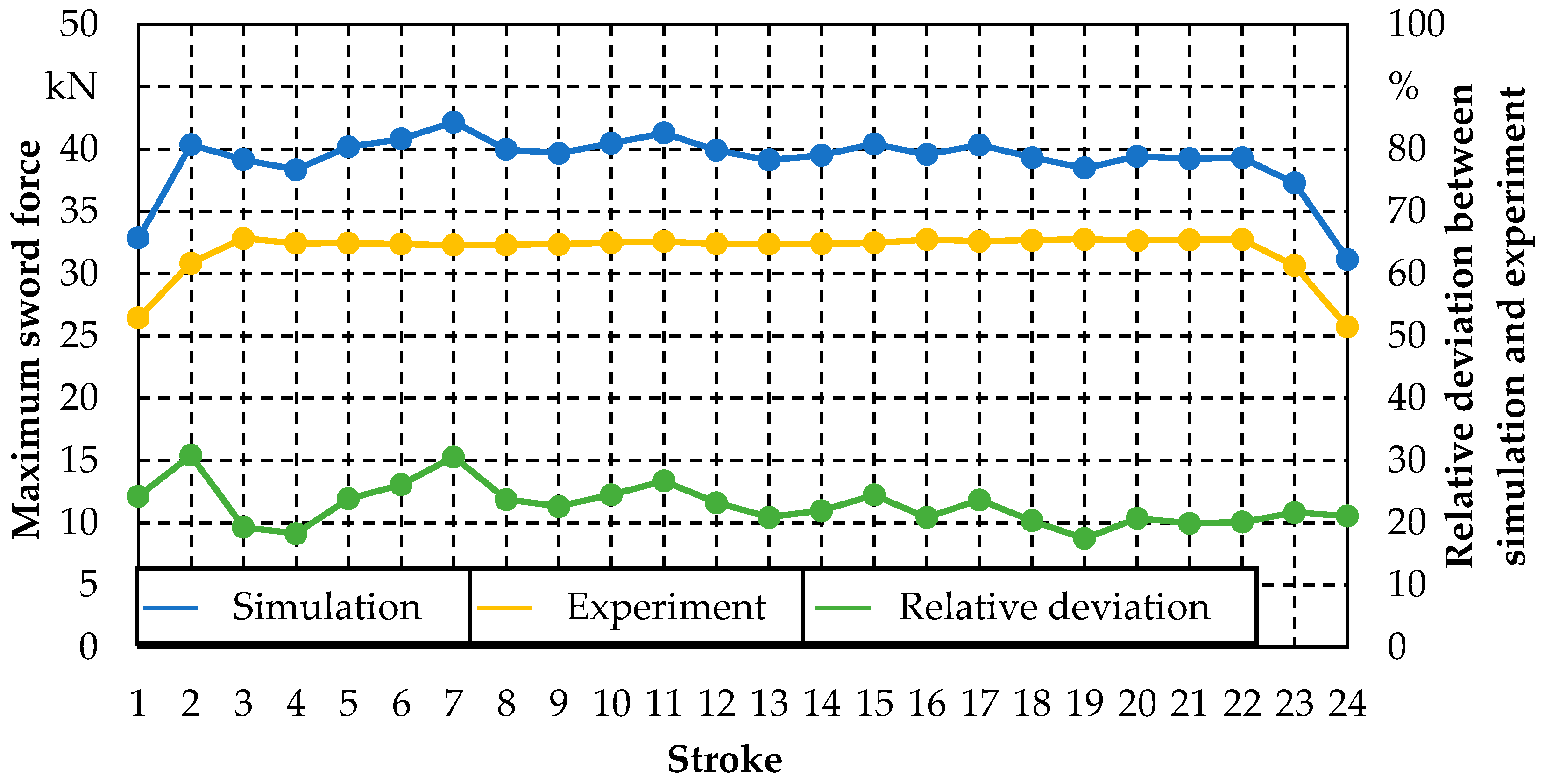
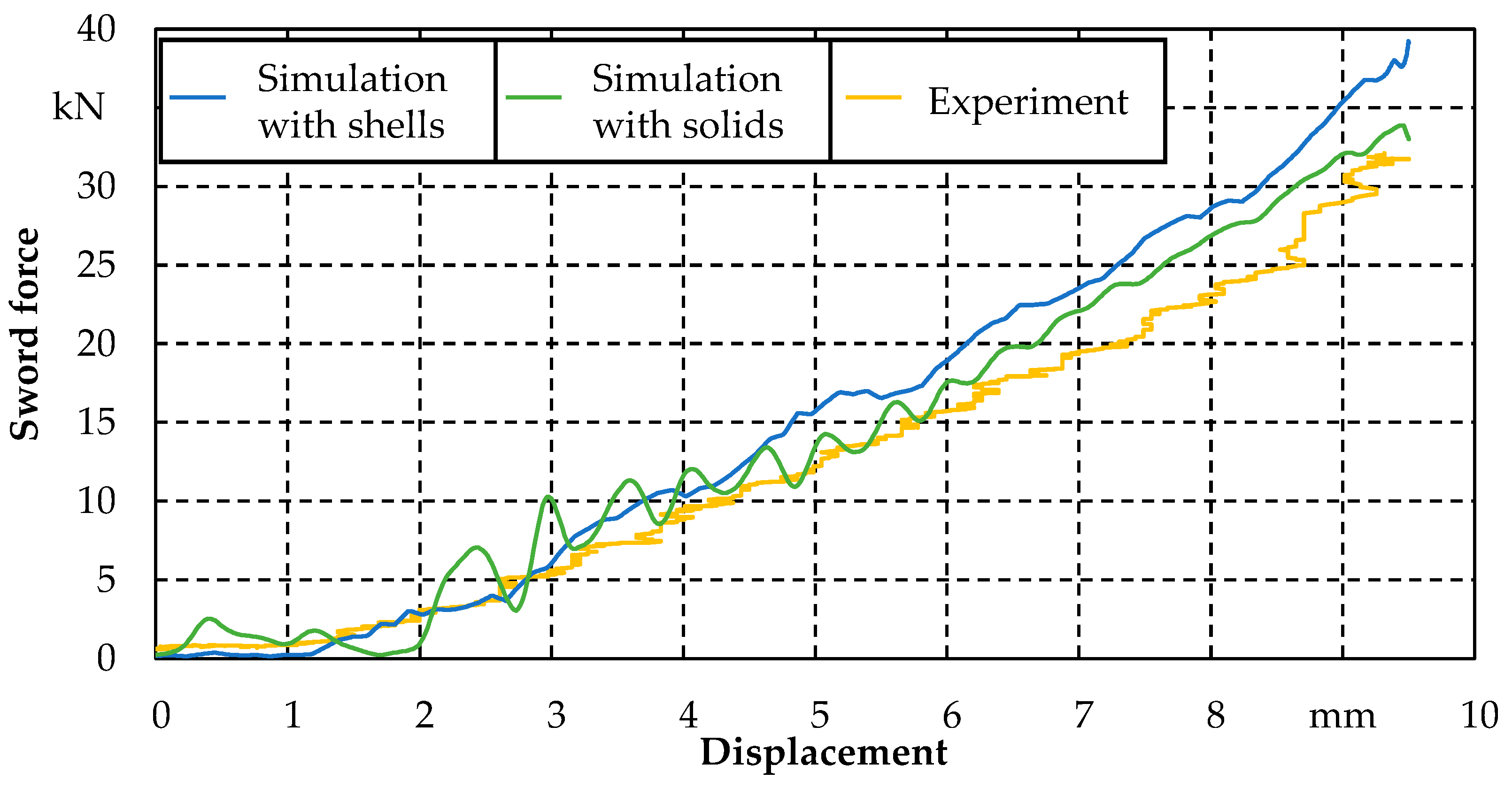
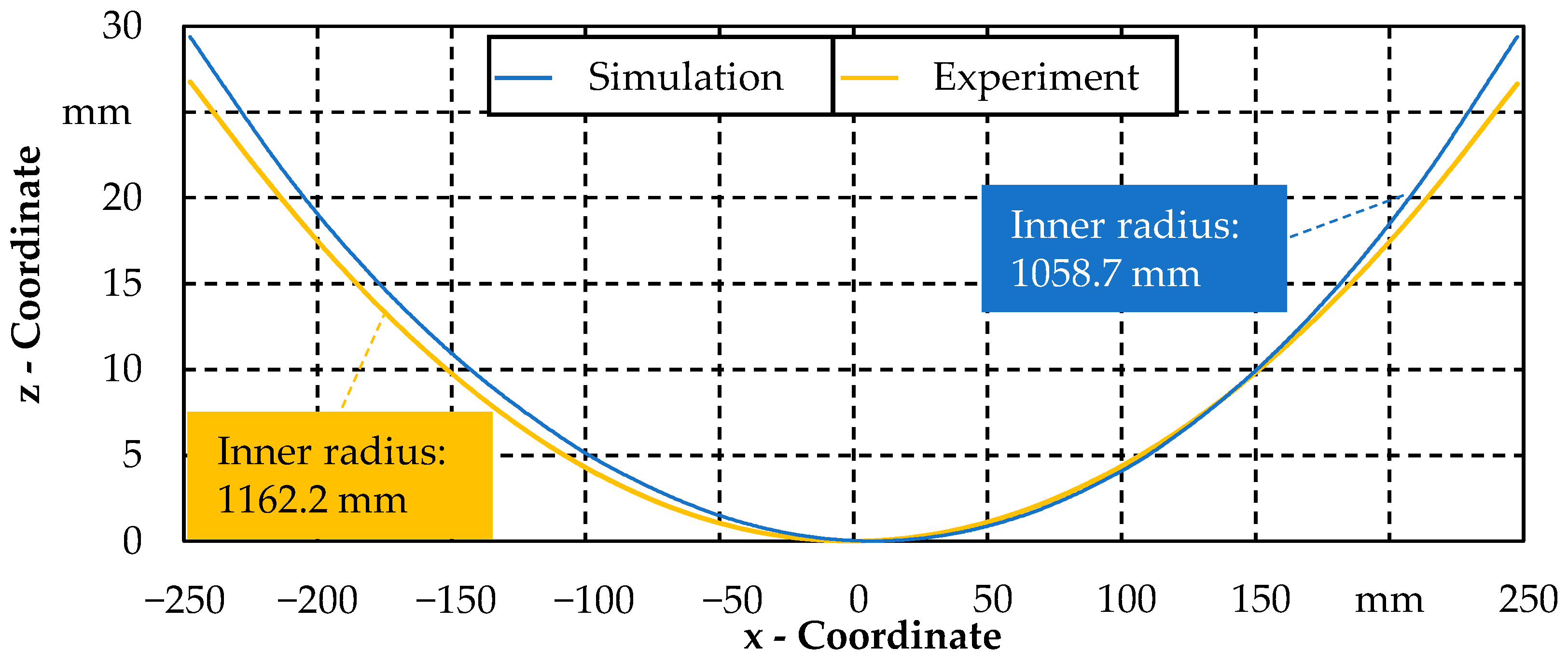
| Test | Plane Strain Compression Test | Shear Test According to Peirs | Tensile Test with Notched Specimen |
|---|---|---|---|
| Test setup | Plane strain compression anvil:
| Specimen:
| Specimen:
|
| Evaluation method | Compensation of machine suspension on the basis of empty runs. Analytical coefficient of friction determination according to Becker and Pöhlandt [30]. Evaluation with correction of the friction and shear components and use of the effective tool width according to Chermette et al. [31]. | Shear strain calculation following the approach by Merklein and Biasutti [32]. | Calculation of plane strain flow curves based on homogenous strain zone identification in accordance to Flores et al. [33]. |
Disclaimer/Publisher’s Note: The statements, opinions and data contained in all publications are solely those of the individual author(s) and contributor(s) and not of MDPI and/or the editor(s). MDPI and/or the editor(s) disclaim responsibility for any injury to people or property resulting from any ideas, methods, instructions or products referred to in the content. |
© 2023 by the authors. Licensee MDPI, Basel, Switzerland. This article is an open access article distributed under the terms and conditions of the Creative Commons Attribution (CC BY) license (https://creativecommons.org/licenses/by/4.0/).
Share and Cite
Jepkens, J.; Müller, P.; Wester, H.; Hübner, S.; Wehrmann, S.; Behrens, B.-A. Simulation and Validation of an Incremental Bending Process for Cylindrical Fuselage Components. Aerospace 2024, 11, 14. https://doi.org/10.3390/aerospace11010014
Jepkens J, Müller P, Wester H, Hübner S, Wehrmann S, Behrens B-A. Simulation and Validation of an Incremental Bending Process for Cylindrical Fuselage Components. Aerospace. 2024; 11(1):14. https://doi.org/10.3390/aerospace11010014
Chicago/Turabian StyleJepkens, Jan, Philipp Müller, Hendrik Wester, Sven Hübner, Simon Wehrmann, and Bernd-Arno Behrens. 2024. "Simulation and Validation of an Incremental Bending Process for Cylindrical Fuselage Components" Aerospace 11, no. 1: 14. https://doi.org/10.3390/aerospace11010014
APA StyleJepkens, J., Müller, P., Wester, H., Hübner, S., Wehrmann, S., & Behrens, B.-A. (2024). Simulation and Validation of an Incremental Bending Process for Cylindrical Fuselage Components. Aerospace, 11(1), 14. https://doi.org/10.3390/aerospace11010014







